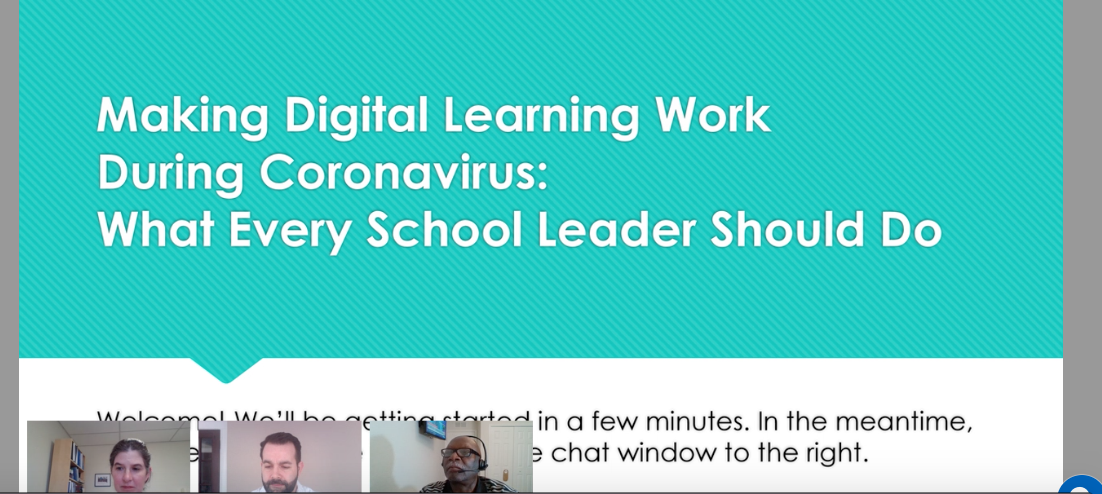“These are very difficult, difficult times,” AFSA President Ernest Logan said during the opening of the professional development webinar, “Making Digital Learning Work During the Coronavirus Crisis.” “There are no easy answers to the questions we are all facing regarding our work and families.”
More than 800 participants registered for an online learning opportunity from JASON Learning and the American Federation of School Administrators to better understand the basics of distance learning.
The one-hour session, which can be watched on demand, was hosted by Logan and Pat Shea, executive vice president of JASON, and Amy O’Neal, the group’s director of education and professional development. It was the first of what will be a number of chances for the union to provide guidance and insight to the new normal situation of online teaching and distance learning.
“We have been lobbying in Congress the last few weeks to make sure our needs and the needs of our students are addressed,” Logan said. “We will all be working in a trial-and-error mode to figure out what works best in our communities.”
JASON Learning got its start 30 years ago as a means for children to “accompany” explorer Robert Ballard, who discovered the Titanic. It has honed and refined curricula and approaches to help students learn remotely.
Shea described the moment facing American educators as a “collective Apollo 13 moment” that has school districts, leaders and staff working with “the digital equivalent of duct tape to get through these initial few weeks.”
He outlined JASON’s guiding principles:
- Learning can happen irrespective of distance or time
- Technology as an enabler, not a driver
- Community and connection (create community)
- Empowered teachers
- High-quality content
- Equity and accessibility
These principles can be defined in many ways, O’Neal noted, but connection is key. “It’s really about staying connected,” she said, “you have to make sure kids stay connected” to school and teachers. Speaking specifically to empowering teachers, O’Neal stressed they know their students best, so administrators should let their teachers figure out how those students will best learn.
Connection can take many forms, O’Neal said. She gave as one example an elementary school in Connecticut that is having different educators read a book each night; that video is posted each day to the school’s website. Having such a habit helps provide structure for students and their families, who know where to go and when to go for the new content, and provides the connection piece as well—educators are familiar to all students; even if they don’t specifically teach a child who is watching, theirs still is a familiar face.
As webinars allow participants to ask questions and make comments in real time, connections were made in the space of this hour as well. Those watching suggested recording lessons to view, getting together with your school team to focus on what your program needs and what has been important to your school—and even for conversations after the webinar, as Chicago Principals and Administrators Association (AFSA Local 2) President Troy LaRaviere did with other Windy City educators.
Participants also offered resources, answered each other’s questions and commented on structural issues normally outside the school’s realm, requiring schools to get involved to support families, such as ensuring Wi-Fi service at home, electricity for those who have been shut off, and cable/internet access. On the latter issue, O’Neal relayed the anecdote of one local school district partnering with local business and getting free Wi-Fi for school families.
One hot topic was having a centralized location for the district. O’Neal said “in the absence of a district-level plan,” a school could serve as its own central location. Or, she said, “if you have principals willing to work together, that’s another thought.”
JASON Learning’s Shea and O’Neal laid out what the distance learning process looks like at the beginning and throughout its development, urging participants to be flexible in their expectations, be ready to experiment and be open to new ideas.
They noted that, like any other process, these new habits and patterns are laying the “infrastructure” for longer-term solutions—and that incrementally, educators will get to content resources, professional development, and tools and techniques.
Other discussions focused on teacher professional development, hooking and engaging students from the start, nondigital home activities, assessments, teacher evaluations and equity.
Shea implored participants to “start thinking about that things will not go back to exactly the way they were before.”
While virtually glitch-free, there were a few dropouts and audio problems that routinely happen with online activity, prompting AFSA Executive Vice President Leonard Pugliese to ask “one thing that stands out though is how do we [prepare] for the inevitable digital glitches that will arise?”
JASON Learning also is offering free online access to its digital platform. To learn more, join a Friday, March 27, webinar at 1 p.m. EDT.

